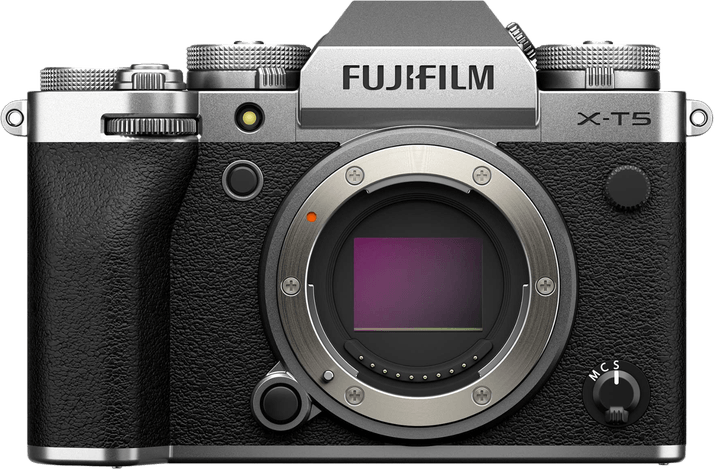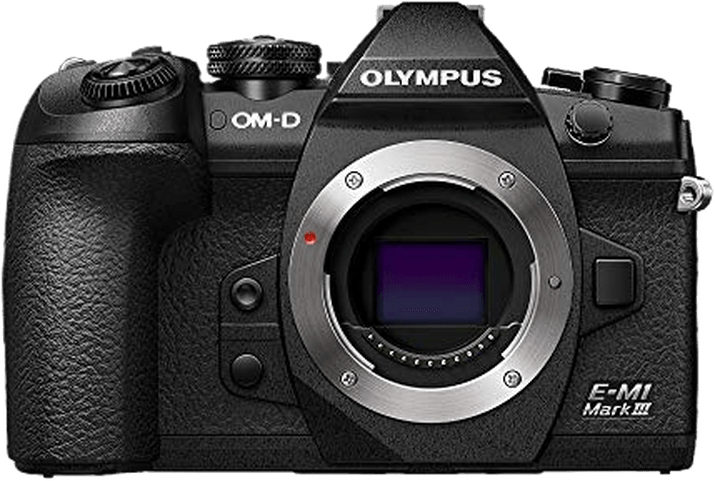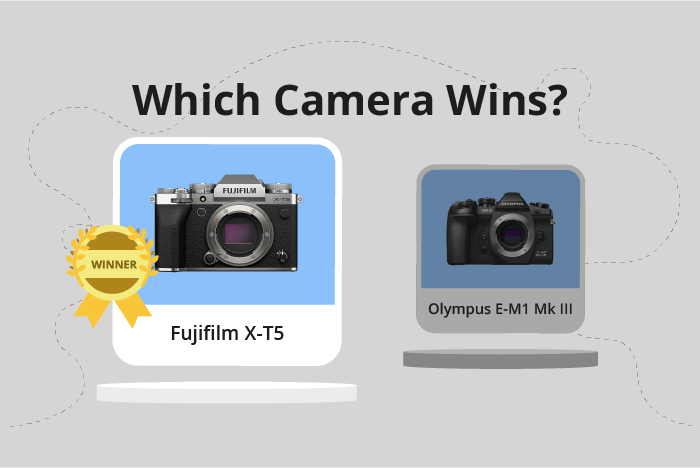Fujifilm X-T5 vs Olympus OM-D E-M1 Mark III Comparison
Fujifilm X-T5

Olympus OM-D E-M1 Mark III

The Fujifilm X-T5 takes the lead with a score of 81/100, outperforming the Olympus OM-D E-M1 Mark III, which scored 72/100. Both cameras are mirrorless and were announced in February of their respective release years, 2022 for the X-T5 and 2020 for the E-M1 Mark III.
The two cameras share similar dimensions, with the X-T5 measuring 130 x 91 x 64mm and the E-M1 Mark III measuring 134 x 91 x 69mm. However, the Fujifilm X-T5 is lighter, weighing 557g compared to the Olympus’s 580g.
The Fujifilm X-T5 not only scores higher but also comes at a lower launch price of $1699, compared to the Olympus OM-D E-M1 Mark III’s $1799. This makes the X-T5 more cost-effective while offering better performance.
On the other hand, the Olympus E-M1 Mark III has the advantage of being on the market for a longer period, providing users with more opportunities to find deals and discounts on the camera.
Taking these factors into account, the Fujifilm X-T5 emerges as the superior option, offering better value, performance, and a lighter weight. The Olympus OM-D E-M1 Mark III, while still a good camera, may appeal to those who prefer to invest in a more established model.
Fujifilm X-T5 vs Olympus OM-D E-M1 Mark III Overview and Optics
The Fujifilm X-T5 outperforms the Olympus OM-D E-M1 Mark III in the optics department with a score of 81/100, a 13-point lead over the Olympus’ 68/100. Both cameras share similarities, including CMOS sensors, processors, image stabilization, and lens mounts. However, the Fujifilm X-T5 boasts superior specifications in certain areas, contributing to its higher score.
The X-T5 has a significant advantage in megapixels, offering 40 compared to the E-M1 Mark III’s 20. This allows the Fujifilm camera to capture greater detail and produce higher resolution images. The X-T5 also has a larger APS-C sensor size, which contributes to better low-light performance and overall image quality. Furthermore, the Fujifilm X lens mount provides access to a wide range of high-quality lenses for various shooting situations.
On the other hand, the Olympus E-M1 Mark III excels in shooting speed with an impressive 60 frames per second, compared to the X-T5’s 15. This makes the Olympus camera better suited for capturing fast-moving subjects and action photography. Additionally, the E-M1 Mark III has a DXOMARK sensor score of 80, providing a measurable indicator of its sensor performance. Unfortunately, the X-T5 lacks a DXOMARK score as Fujifilm cameras are not evaluated by DXOMARK.
Despite these advantages for the Olympus camera, the Fujifilm X-T5’s higher megapixel count, larger sensor size, and versatile lens mount make it the superior choice in terms of optics. The Olympus E-M1 Mark III’s faster shooting speed may be appealing to action photographers, but overall, the X-T5 offers more impressive optical capabilities.
Fujifilm X-T5 vs Olympus OM-D E-M1 Mark III Video Performance
The Fujifilm X-T5 outperforms the Olympus OM-D E-M1 Mark III in video capabilities with a score of 87/100 compared to 83/100. Both cameras share some video specifications, such as a maximum frame rate of 60fps and built-in time-lapse functionality.
The Fujifilm X-T5 has a higher maximum video resolution of 6K, which translates to video dimensions of 6240×4160. This advantage allows the X-T5 to capture more detail and produce sharper videos compared to the Olympus E-M1 Mark III. The higher resolution also provides more flexibility for cropping and stabilizing footage in post-production.
On the other hand, the Olympus E-M1 Mark III offers a maximum video resolution of 4K with video dimensions of 4096×2160. While this is lower than the X-T5, it is still a respectable resolution for most video applications. The E-M1 Mark III may have some advantages in other areas, but they do not surpass the X-T5 in terms of video capabilities.
In terms of video performance, the Fujifilm X-T5 is the clear winner due to its higher video resolution and larger video dimensions. The Olympus E-M1 Mark III, while having a slightly lower score, still provides satisfactory video quality for most users. However, for those seeking the best video capabilities, the Fujifilm X-T5 is the superior choice.
Fujifilm X-T5 vs Olympus OM-D E-M1 Mark III Features and Benefits
The Fujifilm X-T5 emerges as the winner in the features comparison, with a score of 85/100, while the Olympus OM-D E-M1 Mark III trails closely behind with a score of 83/100. Both cameras share common specifications, including a 3-inch screen size, touchscreen capabilities, flip screens, and the absence of GPS. Additionally, both cameras are equipped with WIFI and Bluetooth connectivity.
The Fujifilm X-T5 outperforms the Olympus OM-D E-M1 Mark III in terms of screen resolution. It boasts a resolution of 1,840,000 dots, providing a sharper and more detailed display than the Olympus OM-D E-M1 Mark III, which has a resolution of 1,037,000 dots. This higher resolution enhances the user experience, especially when reviewing images and navigating menus on the screen.
While the Olympus OM-D E-M1 Mark III does not surpass the Fujifilm X-T5 in any specific feature, it remains a strong competitor due to its overall balanced performance. With only a 2-point difference in the feature score, the Olympus model proves to be a reliable and capable camera.
Taking into account the similarities and differences between the two cameras, the Fujifilm X-T5 stands out as the superior choice due to its higher feature score and better screen resolution. However, the Olympus OM-D E-M1 Mark III remains a viable option for photographers looking for a well-rounded camera with a slightly lower feature score. Both cameras offer a range of useful features, but the Fujifilm X-T5’s edge in screen resolution ultimately sets it apart from its competitor.
Fujifilm X-T5 vs Olympus OM-D E-M1 Mark III Storage and Battery
The Fujifilm X-T5 outperforms the Olympus OM-D E-M1 Mark III in storage and battery with a score of 76/100, while the Olympus scores 71/100. Both cameras have two memory card slots and accept SD, SDHC, and SDXC cards. They also offer USB charging capabilities.
The X-T5 surpasses the E-M1 Mark III in battery life, providing 580 shots compared to the Olympus’ 420 shots. The Fujifilm uses an NP-W235 battery, while the Olympus relies on a BLH-1 battery. This longer battery life makes the X-T5 more suitable for extended shooting sessions.
However, the E-M1 Mark III has an advantage in memory card compatibility. One of its slots supports the faster UHS-II standard, allowing for quicker data transfer compared to the X-T5’s UHS-I compatibility.
Taking these factors into account, the Fujifilm X-T5 holds a slight edge in storage and battery performance due to its longer battery life. The Olympus OM-D E-M1 Mark III, though, offers an advantage in memory card speed with its UHS-II compatibility.
Alternatives to the Fujifilm X-T5 and Olympus OM-D E-M1 Mark III
Are you still undecided about which camera is right for you? Have a look at these popular comparisons that feature the Fujifilm X-T5 or the Olympus OM-D E-M1 Mark III:

